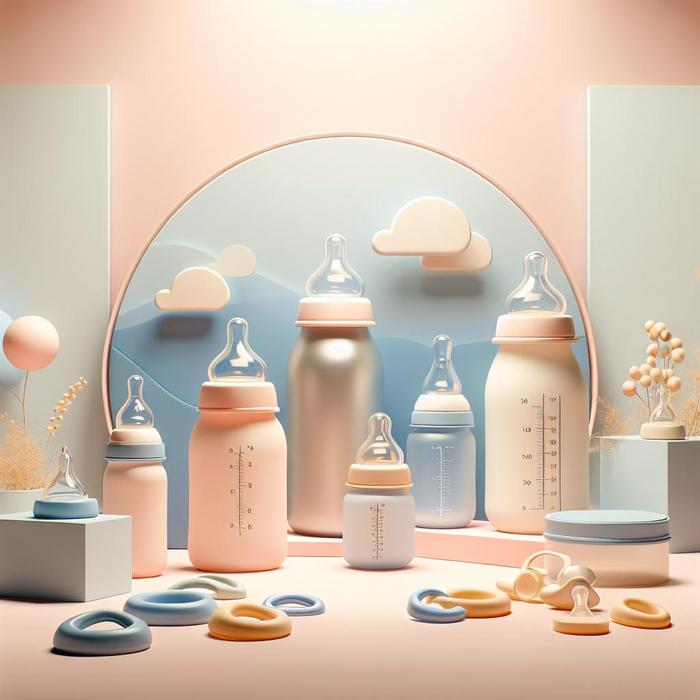The Safety Behind Baby Bottle Materials
Understanding the Importance of Safe Baby Bottles
We all care immensely about our little ones’ health and wellbeing. Therefore, one of the most critical decisions as a parent is choosing the right feeding tools, specifically, safe baby bottles. The concern stems from the fact that bottle feeding is an integral part of a baby’s early development that significantly contributes to their nutrition and overall health.
In this context, the material of the baby bottle becomes a significant factor. Read on to understand why safe bottle materials are essential, what options are available, and how to make an informed decision for your baby.
The Relevance of Baby Bottle Materials
Feeding your baby is not just about the food they consume, but also the medium through which they ingest it. Bottles made from hazardous materials could potentially leach harmful chemicals into the baby’s food, especially when subjected to high temperatures during sterilization and warming. Therefore, mastering the art of bottle feeding also involves ensuring the safety of baby bottles.
Here are the most common baby bottle materials:
- Plastic
- Glass
- Stainless Steel
- Silicone
Pros and Cons of Different Baby Bottle Materials
Each material has its advantages and drawbacks. Let’s delve deeper to understand each type:
Plastic Baby Bottles
Plastic bottles are relatively affordable, lightweight, and shatterproof. However, they can scratch, become cloudy over time, and may contain harmful chemicals like BPA. Therefore, if you opt for plastic, ensure it is BPA-free and replace it regularly.
Glass Baby Bottles
Glass is an excellent alternative for safe baby bottles. It is naturally BPA-free and does not scratch or degrade over time. However, they could break if dropped. Some parents have found the glass vs. plastic or silicone debate helpful in making their choice.
Stainless Steel Baby Bottles
Stainless steel is durable, long-lasting, and naturally free from harmful chemicals. However, these bottles tend to be pricier and may not be translucent, making it difficult to see how much milk is remaining.
Silicone Baby Bottles
Silicone bottles are shatterproof, lightweight, and free of harmful chemicals. But they can be costly and may sometimes retain odors. Some parents find them a great middle-ground, as discussed in this discussion about non-toxic baby bottles.
Choosing the Right Safe Baby Bottle
Deciding on the best material for your baby’s bottle depends on your specific circumstances and preferences. You might want to take into consideration aspects such as durability, cost, safety, and ease of cleaning. For an expanded list of the best healthy baby bottles, consider checking out this sippy cup and baby bottle guide.
In addition to the material, remember that managing feeding times, especially at night, can be crucial to your baby’s comfort and enhancing their sleep routine. Read our tips on managing night feedings for a smoother experience.
Understanding the Health Concerns of Baby Bottle Materials
Many parents express concerns regarding the potential harm of chemicals found in baby bottle materials. One widely known danger is Bisphenol A (BPA), a chemical found in some plastics. BPA can leach into food and drink, potentially affecting your baby’s health.
Regarding potential effects of BPA, the US Food and Drug Administration (FDA) has stated, “Studies pursued by FDA’s National Center for Toxicological Research (NCTR) have shown no effects of BPA from low-dose exposure.” Nonetheless, further research needs to be done to completely understand low-dose BPA exposure effects. The FDA’s current perspective on BPA in food contact applications can be accessed here.
It’s important to note that some manufacturers voluntarily removed BPA from their baby bottle products, and many countries have completely banned its use in baby bottles. More information on choosing BPA-free bottles can be found at Consumer Reports.
Choosing BPA-Free Baby Bottles
Parents looking for BPA-free options can find useful resources online. Websites like WebMD offers lists of BPA-free baby bottles giving you a broader range of safe choices. Using BPA-free bottles helps ensure that your child’s nutrition is not compromised by unwanted chemicals.
Physical Aspects of Baby Bottles
On top of the potential health hazards, it’s important to consider the physical aspects of baby bottles. Aspects like the bottle’s shape and design, the nipple size, and the flow speed can also impact a baby’s feeding experience. Chicco, a renowned baby products manufacturer, offers a useful guide on what to consider when choosing a baby bottle.
Cleaning and Caring for Baby Bottles
Maintaining baby bottles in a good condition is crucial for your baby’s health. Regardless of the type of material, all baby bottles should be thoroughly cleaned and inspected for signs of wear and tear after each feeding.
Plastic baby bottles need to be replaced more often as they can become scratched, making them harder to clean effectively. Glass, stainless steel, and silicone bottles should be regularly checked for chips, cracks, and signs of degradation. Look out for any discoloration, a common indication of wear.
The Argument of Sustainability
Sustainability is becoming an increasing consideration for parents. Plastic bottles, although lightweight and budget-friendly, do not biodegrade and can add to environmental pollution when disposed of improperly. Glass and stainless steel, on the other hand, are recyclable materials. Silicone, though not as environmentally friendly as glass or steel, is more eco-friendly compared to plastic, as it lasts longer and can be recycled.
Following Your Baby’s Preferences
Beyond considering the safety, price, and sustainability of baby bottle materials, another crucial factor is your baby’s comfort and acceptance of the bottle. Some babies may prefer a certain material over others. In the end, you might find that it’s your baby who makes the final choice!
Seeking Medical and Professional Advice
Ultimately, consult with your pediatrician if you have any concerns about your baby’s feeding tools. They can provide you reliable guidance based on your child’s specific needs and medical history.
The journey of parenthood is full of important decisions to make. Striving to provide the best for our children, we all want to ensure safety in every possible aspect, starting with the very vessels they use for nourishment. We hope this post is a helpful guide in your journey to finding the perfect baby bottle.

